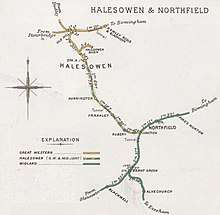Halesowen Railway
Halesowen Railway | |||||||||||||||||||||||||||||||||||||||||||||||||||||||||||||||||||||||||||||||||||||||||||
|---|---|---|---|---|---|---|---|---|---|---|---|---|---|---|---|---|---|---|---|---|---|---|---|---|---|---|---|---|---|---|---|---|---|---|---|---|---|---|---|---|---|---|---|---|---|---|---|---|---|---|---|---|---|---|---|---|---|---|---|---|---|---|---|---|---|---|---|---|---|---|---|---|---|---|---|---|---|---|---|---|---|---|---|---|---|---|---|---|---|---|---|
| |||||||||||||||||||||||||||||||||||||||||||||||||||||||||||||||||||||||||||||||||||||||||||

The Halesowen Railway, also known as the Halesowen and Northfield Railway and the Halesowen Joint Railway, was a standard gauge railway in what is now the West Midlands of England. It connected the Great Western Railway's branch from Old Hill to Halesowen (opened 1878) with the Midland Railway’s Birmingham to Gloucester line at Longbridge Junction (formerly known as Halesowen Junction) near the present Longbridge station. The term "Halesowen Railway" is sometimes applied to the whole line between Old Hill and Longbridge but, strictly, it applies only to the portion south of Halesowen.[1]
Opening
The Great Western Railway (GWR) opened their branch to Halesowen from Old Hill (on the line between Stourbridge Junction and Birmingham Snow Hill) on 1 March 1878.[2] The new branch was 1 mile 43 chains (2.5 km) long from the junction at Old Hill, and on the same day, the GWR also opened the 2-mile-65-chain (4.5 km) link between Old Hill and Netherton,[2] the latter being on the line from Stourbridge Junction to Wolverhampton Low Level.[3] Construction of the line between Halesowen and Northfield started in 1878 and the railway opened as the Halesowen and Northfield Railway on 10 September 1883.[4] It later became the Halesowen Joint Railway - a joint operation between the Great Western and Midland Railways.[5] It became jointly owned by the GWR and the London Midland & Scottish Railway in 1923[6] and British Railways in 1948.
Closure
It had a relatively short passenger railway life, the stations on the line being closed in 1919. There were freight trains and workers' special services to the Austin Rover Works up to 1960.
The line was closed altogether in 1964. The former station at Hunnington has been converted into a house and the other intermediate station at Rubery has been demolished. A short section of the line remained at the southern end to serve the Longbridge motor plant although there was no traffic after 1995 and that section was lifted during the redevelopment of the Longbridge site subsequent to its closure.
Campaign for Better Transport have added the railway to their recommendations for reopening.[7]
Structures
A significant structure on the line was the Dowery Dell Viaduct, between Halesowen and Rubery. It was dismantled in 1964.
- Dowery Dell Viaduct
 Dowery Dell Viaduct showing one pier
Dowery Dell Viaduct showing one pier Dowery Dell Viaduct with steam train passing towards Longbridge
Dowery Dell Viaduct with steam train passing towards Longbridge
References
- "Halesowen Railway". Miac.org.uk. Retrieved 2 April 2012.
- MacDermot, E.T. (1931). History of the Great Western Railway, vol. II: 1863-1921. Paddington: Great Western Railway. p. 602. OCLC 55853736.CS1 maint: ref=harv (link)
- Conolly, W. Philip (January 1976). British Railways Pre-Grouping Atlas and Gazetteer (5th ed.). Shepperton: Ian Allan. p. 15, section G4. ISBN 0-7110-0320-3. EX/0176.CS1 maint: ref=harv (link)
- "Austin Railways". Austinmemories.com. Archived from the original on 26 March 2012. Retrieved 2 April 2012.
- M D Norton. "Halesowen Railway Line". Photobydjnorton.com. Retrieved 2 April 2012.
- Awdry, Christopher (1990). Encyclopaedia of British Railway Companies. London: Guild Publishing. p. 216. CN 8983.CS1 maint: ref=harv (link)
- "Re-opening rail lines". Campaign for Better Transport.